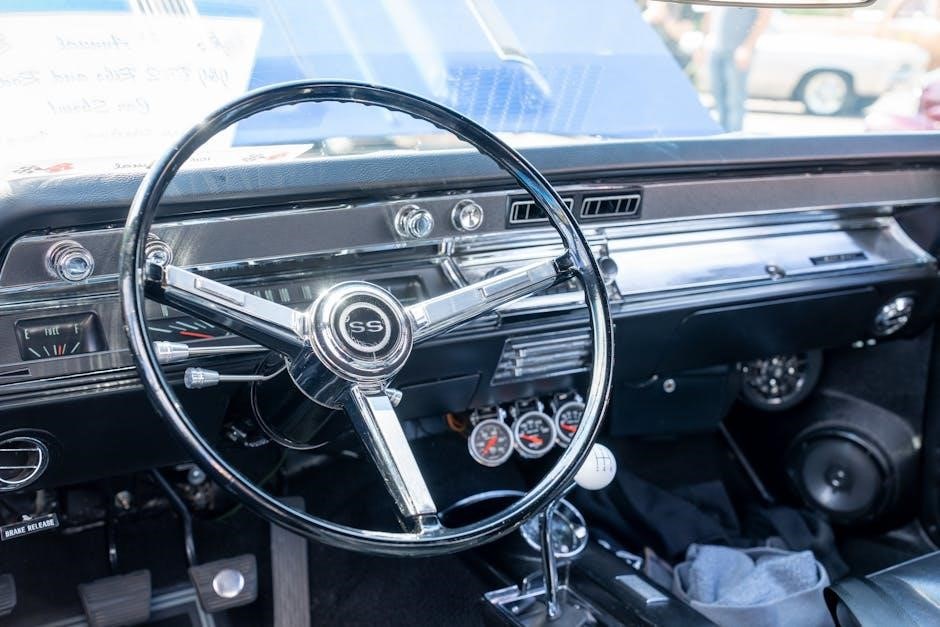A car manual is a vital resource for vehicle owners, offering detailed guidance on maintenance, operation, and troubleshooting. For NYT readers, it serves as an essential tool, catering to a diverse audience, from first-time car owners to experienced drivers and automotive enthusiasts, ensuring informed decision-making and enhanced ownership experiences.
Importance of Car Manuals
Car manuals are essential resources designed to empower vehicle owners with comprehensive knowledge about their cars. They provide detailed instructions for maintenance, troubleshooting, and optimal usage, ensuring safety and longevity of the vehicle. For first-time car owners, manuals serve as a guide to understanding their car’s features and proper care. Experienced drivers benefit from advanced tips and specifications, while enthusiasts gain insights into performance optimization. By offering clear, concise information, car manuals bridge the gap between technical complexity and user-friendly guidance, making them indispensable for anyone aiming to maximize their driving experience and protect their investment.
Relevance to New York Times Audience
Car manuals hold significant relevance for the New York Times audience, as they cater to a diverse readership with varying interests and expertise levels. For urban commuters, the manuals provide practical guidance for maintaining and optimizing their vehicles in bustling city environments. For enthusiasts, they offer detailed insights into performance and customization. The NYT audience, known for valuing well-researched and authoritative content, appreciates the precision and reliability of car manuals. Additionally, the alignment with lifestyle-focused reporting ensures that car manuals resonate with readers who prioritize both functionality and engagement. By bridging technical details with accessible language, car manuals serve as a valuable resource for NYT readers seeking to enhance their driving experience and automotive knowledge.

Primary Audience: Car Owners
Car manuals are primarily written for car owners, providing essential guidance for safe operation, maintenance, and troubleshooting. They cater to diverse expertise levels, ensuring clarity and practicality for all drivers.
First-Time Car Owners
First-time car owners benefit immensely from car manuals, as they provide a foundational understanding of vehicle operation and maintenance. These manuals are designed to be user-friendly, offering clear instructions on essential tasks such as oil changes, tire pressure checks, and emergency procedures. They also explain complex systems in simple terms, helping new owners grasp key concepts without prior knowledge. For NYC residents, where driving conditions can be challenging, manuals often include tips for urban driving and parking. Additionally, they cover warranty information and scheduled maintenance, ensuring owners can keep their vehicles in optimal condition. By prioritizing clarity and accessibility, car manuals empower first-time owners to build confidence and take control of their ownership experience.
Experienced Drivers
Experienced drivers also find car manuals invaluable, as they often seek detailed technical insights to optimize their driving experience. These manuals provide advanced troubleshooting guides, specifications, and maintenance schedules tailored to their vehicle. For those familiar with car mechanics, manuals offer in-depth information on performance optimization and customizations. Additionally, they serve as a reference for understanding new technologies integrated into modern vehicles. Even seasoned drivers benefit from clarity on advanced features like adaptive cruise control or hybrid systems. Manuals also act as a go-to resource for DIY repairs and upgrades, empowering experienced drivers to maintain their cars efficiently. This aligns with the NYT audience’s preference for comprehensive, reliable information, making car manuals a trusted companion for drivers of all skill levels.
Automotive Enthusiasts
Automotive enthusiasts, who often have a deep passion for cars, rely on car manuals to gain detailed insights into their vehicles’ mechanics and performance capabilities. These manuals are a treasure trove of technical specifications, maintenance tips, and customization options, catering to enthusiasts who enjoy fine-tuning their cars. For those who appreciate the heritage and evolution of their vehicles, manuals provide historical context and design philosophies. They also serve as a resource for DIY projects and modifications, allowing enthusiasts to push their cars’ limits creatively. By offering both practical guidance and inspirational content, car manuals become an essential tool for automotive enthusiasts seeking to enhance their driving experience and connection with their vehicles.

Secondary Audience: Automotive Professionals
Automotive professionals, such as mechanics and technicians, rely on car manuals for precise technical details, diagnostic guidance, and repair instructions to maintain and improve vehicle performance.
Mechanics
Mechanics
Mechanics are a primary audience for car manuals, as these guides provide essential technical details for diagnosing, repairing, and maintaining vehicles. Manuals offer step-by-step instructions, specifications, and troubleshooting tips, enabling mechanics to work efficiently. They include torque values, fluid capacities, and wiring diagrams, which are critical for precise repairs. Additionally, manuals help mechanics understand advanced systems, such as fuel injection and electronic control modules, ensuring they can handle modern vehicles effectively. For mechanics in New York, where diverse vehicle types are common, manuals are indispensable for staying updated on the latest automotive technologies and procedures, making them a vital tool for professional success and customer satisfaction.
Technicians
Car manuals are equally valuable for technicians, offering detailed diagnostic procedures, system overviews, and repair specifications. These guides enable technicians to efficiently identify and resolve issues, ensuring accurate and efficient service. Manuals provide comprehensive information on electrical systems, engine management, and advanced technologies like ADAS (Advanced Driver-Assistance Systems). For technicians serving New York’s diverse vehicle population, manuals are crucial for staying updated on the latest automotive innovations. They also serve as a reference for warranty repairs and factory-recommended procedures, ensuring compliance with OEM standards. By leveraging car manuals, technicians can deliver high-quality, precise repairs, maintaining customer trust and satisfaction in a competitive market.

Tertiary Audience: Enthusiasts and Experts
Car manuals cater to enthusiasts and experts seeking advanced technical insights, detailed specifications, and historical context, fulfilling their passion for deep customization and precision tuning.
Advanced Users and Experts
Advanced users and experts, such as seasoned automotive technicians or car enthusiasts, rely on car manuals for detailed technical specifications, diagnostic procedures, and advanced maintenance techniques; These individuals often seek in-depth information to troubleshoot complex issues, optimize performance, or customize vehicles. For them, a car manual serves as a comprehensive reference guide, offering insights into engine mechanics, electrical systems, and advanced diagnostics. It also provides a foundation for modifications or upgrades, aligning with their passion for precision and innovation. By catering to this audience, car manuals become indispensable tools for those who demand expertise-level knowledge, ensuring they can maximize their vehicle’s potential and stay informed about the latest advancements in automotive technology.

Car Manual Writing Style for NYT Audience
Car manuals for NYT readers should blend technical accuracy with engaging storytelling, offering clear, concise instructions while maintaining a sophisticated tone that appeals to both enthusiasts and casual owners.
Informative and Engaging Content
Car manuals tailored for the NYT audience must strike a balance between being informative and engaging. Clarity is paramount, ensuring complex technical details are presented in an accessible manner. The content should cater to a diverse readership, from novice drivers to seasoned enthusiasts, by offering both foundational knowledge and advanced insights. Engaging storytelling techniques, such as real-world applications and relatable scenarios, can enhance reader interest. Additionally, incorporating practical tips, troubleshooting guides, and maintenance advice makes the manual a go-to resource. Visual aids like diagrams and step-by-step instructions further improve comprehension. By blending precision with readability, the manual becomes an indispensable tool for NYT readers seeking to enhance their automotive experience.
Clarity and Accessibility
Car manuals designed for NYT readers prioritize clarity and accessibility, ensuring that information is easy to understand for all skill levels. Simplified language avoids overly technical jargon, making the content approachable for both novices and experts. Strategic organization of information, such as indexed sections and clear headings, allows readers to quickly locate specific guidance. Visual aids, including diagrams and illustrations, complement written instructions to enhance comprehension. Accessibility extends to digital formats, with features like search functions and zoom capabilities. By focusing on readability and user-friendly design, these manuals empower readers to confidently navigate car maintenance and operation, regardless of their prior knowledge or experience.

Relevance to NYT Readers
Car manuals offer NYT readers insightful, practical advice, enhancing their ownership experience while catering to diverse interests, from everyday driving to automotive enthusiasm.
NYT Crossword Clue Reference
The New York Times crossword puzzle often includes clues that resonate with a wide audience, including car enthusiasts. A clue like “For whom a car manual is written” might appear, testing solvers’ knowledge of automotive resources. This reference highlights the universal relevance of car manuals, appealing to both casual puzzlers and avid car owners. The NYT audience, known for its diverse interests, would appreciate the connection between everyday tools like car manuals and intellectual hobbies like crosswords. Such clues not only engage readers but also underscore the practical value of car manuals in modern life, making them a relatable and accessible topic for a broad demographic. This crossover reflects the NYT’s ability to blend lifestyle, education, and entertainment seamlessly.
Broad Relevance to Diverse Interests
A car manual’s content is crafted to cater to a wide range of interests, ensuring its relevance to diverse audiences. For urban commuters, the manual provides practical tips for navigating city streets and optimizing fuel efficiency. For rural drivers, it offers insights into maintaining vehicles in challenging terrain. Additionally, the manual addresses the needs of eco-conscious drivers, highlighting features that reduce environmental impact. Whether you own a vintage car or the latest electric vehicle, the manual’s comprehensive guidance ensures it remains a valuable resource. By covering such a broad spectrum of topics, the car manual becomes an indispensable companion for anyone who values informed and responsible vehicle ownership, aligning perfectly with the New York Times audience’s diverse interests and lifestyles.

Content Alignment with Audience Preferences
Car manuals tailored for NYT readers align with their lifestyle, offering practical advice for urban commuting, eco-friendly practices, and tech-savvy features, ensuring relevance to their daily routines.
They balance depth, providing essential information for quick reference while offering detailed insights for enthusiasts, catering to both casual and advanced users effectively.
Lifestyle and Engagement Patterns
Understanding the lifestyle and engagement patterns of NYT readers is crucial for crafting car manuals that resonate with their needs. Many NYT readers lead busy, urban lifestyles, valuing convenience and efficiency. They often seek content that is easily accessible, concise, and relevant to their daily routines. For car owners, this means manuals should cater to both quick reference and in-depth exploration, depending on the user’s preference. Urban commuters might prioritize troubleshooting guides, while suburban drivers may focus on maintenance schedules. Additionally, the rise of digital platforms aligns with NYT readers’ preference for on-the-go accessibility, making digital car manuals a practical choice. By tailoring content to these patterns, car manuals can enhance the ownership experience and provide real value to NYT readers.
Depth of Information
The depth of information in a car manual is crucial for catering to the diverse needs of NYT readers, who value comprehensive and detailed content. Whether it’s troubleshooting complex issues or understanding advanced features, the manual should provide layered information that appeals to both novice and experienced users. This ensures that readers can access the level of detail they require, from basic maintenance tips to intricate technical specifications. By balancing simplicity with depth, the manual becomes an indispensable resource for car owners seeking to enhance their knowledge and ownership experience. This approach aligns with NYT readers’ expectations for high-quality, informative content that addresses their specific interests and expertise levels.
Car manuals empower owners with essential knowledge, fostering confidence and mastery over vehicle maintenance and operation, ensuring a safer, more enjoyable driving experience tailored for the NYT audience.
Value of Car Manuals to NYT Readers
Car manuals offer significant value to New York Times readers by empowering them with knowledge tailored to their lifestyle and interests. For car owners, these manuals provide clear guidance on maintenance, troubleshooting, and optimizing vehicle performance, which aligns with the practical needs of NYT readers who value informed decision-making. Additionally, car manuals cater to the diverse interests of NYT’s audience, whether they are enthusiasts seeking detailed technical insights or casual drivers looking for straightforward advice. The content is designed to enhance the ownership experience, ensuring safety, efficiency, and satisfaction. This makes car manuals an indispensable resource for NYT readers who appreciate clarity, accessibility, and depth in the information they consume.

The Evolution of Car Manuals
Car manuals have evolved from print to digital, incorporating interactive features and multimedia. This shift enhances accessibility and engagement for modern NYT readers.
From Print to Digital
The evolution of car manuals from print to digital has revolutionized how drivers access information. Traditionally, print manuals were the standard, offering detailed guides in a physical format. However, with advancements in technology, digital manuals have become the preferred choice for many. Digital versions are more accessible, searchable, and easily updated, ensuring users always have the latest information. They also offer interactive features like videos and 3D models, enhancing understanding. For NYT readers, who value convenience and innovation, digital manuals align perfectly with their lifestyle. This shift not only improves user experience but also reduces environmental impact, making it a sustainable choice for modern car owners.
Enhanced Features and Interactivity
The evolution of car manuals has introduced enhanced features and interactivity, making them more accessible and user-friendly. Modern digital manuals now include interactive diagrams, searchable content, and video tutorials, allowing users to navigate information effortlessly. These features cater to the diverse needs of NYT readers, who value depth and clarity. For instance, interactive 3D models enable users to explore vehicle components in detail, while troubleshooting guides provide step-by-step solutions. Additionally, digital manuals often include customizable settings, enabling users to tailor the content to their preferences. These advancements ensure that car manuals are no longer static documents but dynamic tools that enhance the overall ownership experience. Such interactivity aligns perfectly with the expectations of NYT readers, who appreciate innovative and engaging content.
Digital vs. Print Manuals
Digital manuals offer convenience, accessibility, and interactivity, appealing to tech-savvy NYT readers who value instant information and multimedia features like videos and searchable content.
Print manuals provide a tangible, detailed guide preferred by those who enjoy physical media or need reliable access without digital devices, ensuring clarity in complex procedures.
Advantages of Digital Manuals
Digital car manuals offer unparalleled convenience and accessibility, making them a valuable resource for NYT readers. They can be easily accessed on smartphones, tablets, or computers, ensuring that drivers have critical information at their fingertips, no matter where they are. Digital manuals are searchable, allowing users to quickly find specific details without flipping through pages. They are also regularly updated by manufacturers, providing the most current information on vehicle maintenance, troubleshooting, and new features. Additionally, digital manuals reduce clutter and are environmentally friendly, appealing to eco-conscious readers. These benefits make digital manuals an indispensable tool for modern car owners seeking efficiency and reliability in their automotive resources.
Preferability of Print Manuals
For many car owners, print manuals remain the preferred choice due to their tactile nature and ease of reference. The physical format allows drivers to flip through pages effortlessly, making it simpler to locate specific information quickly. Print manuals also eliminate the need for screens, reducing distractions and providing a more immersive experience. Additionally, the visual layout of diagrams and instructions in print can enhance understanding, especially for complex procedures. For enthusiasts and collectors, print manuals often become cherished companions, offering a sense of nostalgia and connection to their vehicles. While digital versions are convenient, the enduring appeal of print manuals lies in their accessibility and the satisfaction of holding a physical guide.

Future Trends in Car Manuals
Integration with Technology
Car manuals will increasingly integrate with smart devices, offering real-time diagnostics and interactive guides, enhancing user experience and problem-solving efficiency for NYT readers.
Personalized Content and AI
AI-driven manuals will tailor information to individual preferences, providing customized maintenance tips and troubleshooting based on driving habits, making content more relevant and accessible.
The integration of technology into car manuals is revolutionizing how users interact with their vehicles. Modern car manuals now incorporate QR codes, linking to video tutorials and interactive guides, which enhance understanding. Augmented reality (AR) features allow users to visualize repairs in 3D, making complex tasks more accessible. Additionally, AI-driven diagnostic tools within digital manuals provide personalized troubleshooting based on specific vehicle data. This seamless fusion of technology and traditional guidance ensures that car manuals remain a vital resource for both novice and experienced users, keeping pace with the evolving needs of car ownership in the digital age.
The future of car manuals lies in leveraging AI and personalized content to cater to individual user needs. By integrating artificial intelligence, manuals can adapt to a driver’s behavior, preferences, and vehicle data, offering tailored guidance. For instance, AI could analyze a user’s driving habits and provide customized maintenance tips or troubleshooting advice. Natural language processing can enable interactive Q&A sections, making manuals more accessible and user-friendly. This evolution ensures that car manuals become dynamic tools, enhancing the ownership experience for NYT readers who value innovation and practicality. Personalized content and AI-driven features will redefine how car owners interact with their vehicles, making manuals indispensable in the digital age.

Why Car Manuals Matter to NYT Readers
Car manuals empower NYT readers with essential knowledge, enabling informed decisions, safety, and efficiency. They provide troubleshooting guides and maintenance tips, enhancing ownership pride and experience.
Enhanced Ownership Experience
A car manual is designed to elevate the ownership experience by providing comprehensive guidance tailored to the user’s needs. It empowers drivers with knowledge, enabling them to optimize their vehicle’s performance, safety, and longevity. For NYT readers, who value precision and depth, the manual serves as an indispensable resource. It offers tips for maintenance, troubleshooting, and understanding advanced features, fostering a sense of control and confidence. By bridging the gap between the driver and their vehicle, the manual enhances the overall driving experience, making it more enjoyable and stress-free. This alignment with the audience’s pursuit of excellence ensures that the manual becomes an essential companion for every car owner.
